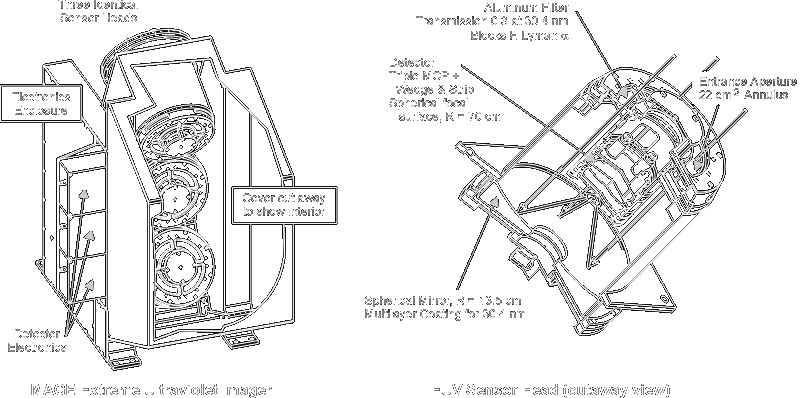
The Extreme Ultraviolet Imager (EUV) images the distribution of He+ in Earth's plasmasphere by detecting its resonantly-scattered emission at 304 Å. It is one of seven scientific instruments on the IMAGE Earth satellite, an element of NASA's MIDEX Program.
Goals. The IMAGE Mission seeks answers to these questions:
Implementation. The approach of the IMAGE Mission is based on simultaneous global imaging of the plasmasphere using neutral atoms, extreme and far ultraviolet light, and radio sounding techniques. Three neutral atom imagers collectively cover the energy range from 10 eV to 200 keV with spatial resolutions of about 8°×8°. FUV imaging tracks the aurora to establish magnetospheric boundary conditions. The Radio Plasma Imager measures electron densities from the magnetopause to the inner plasmasphere (0.1 to 105 cm-3). On March 25th, 2000, IMAGE was launched into an elliptical orbit having an apogee of 8 RE at high northern latitudes.
The Extreme Ultraviolet Imager. Effective imaging of the plasmaspheric He+ requires global “snapshots” in which the high apogee and the wide field of view of EUV provide in a single exposure a map of the entire plasmasphere. The 30.4-nm feature is relatively easy to measure because it is the brightest ion emission from the plasmasphere, it is spectrally isolated, and the background at that wavelength is negligible. Measurements are easy to interpret because the plasmaspheric He+ emission is optically thin, so its brightness is directly proportional to the He+ column abundance.

EUV consists of three identical sensor heads, each having a field of view 30° in diameter. These sensors are tilted relative to one another to cover a fan-shaped field of 84°x30°, which is swept across the plasmasphere by the spin of the satellite. EUV's spatial resolution is ~0.6° or ~0.1 RE in the equatorial plane seen from apogee. The sensitivity is ~0.2 count sec-1 Rayleigh-1, sufficient to map position of the plasmapause with a time resolution of 10 minutes or better.
More information about the EUV instrument and science background is available on the Southwest Research Institute Web site's EUV Imaging section.